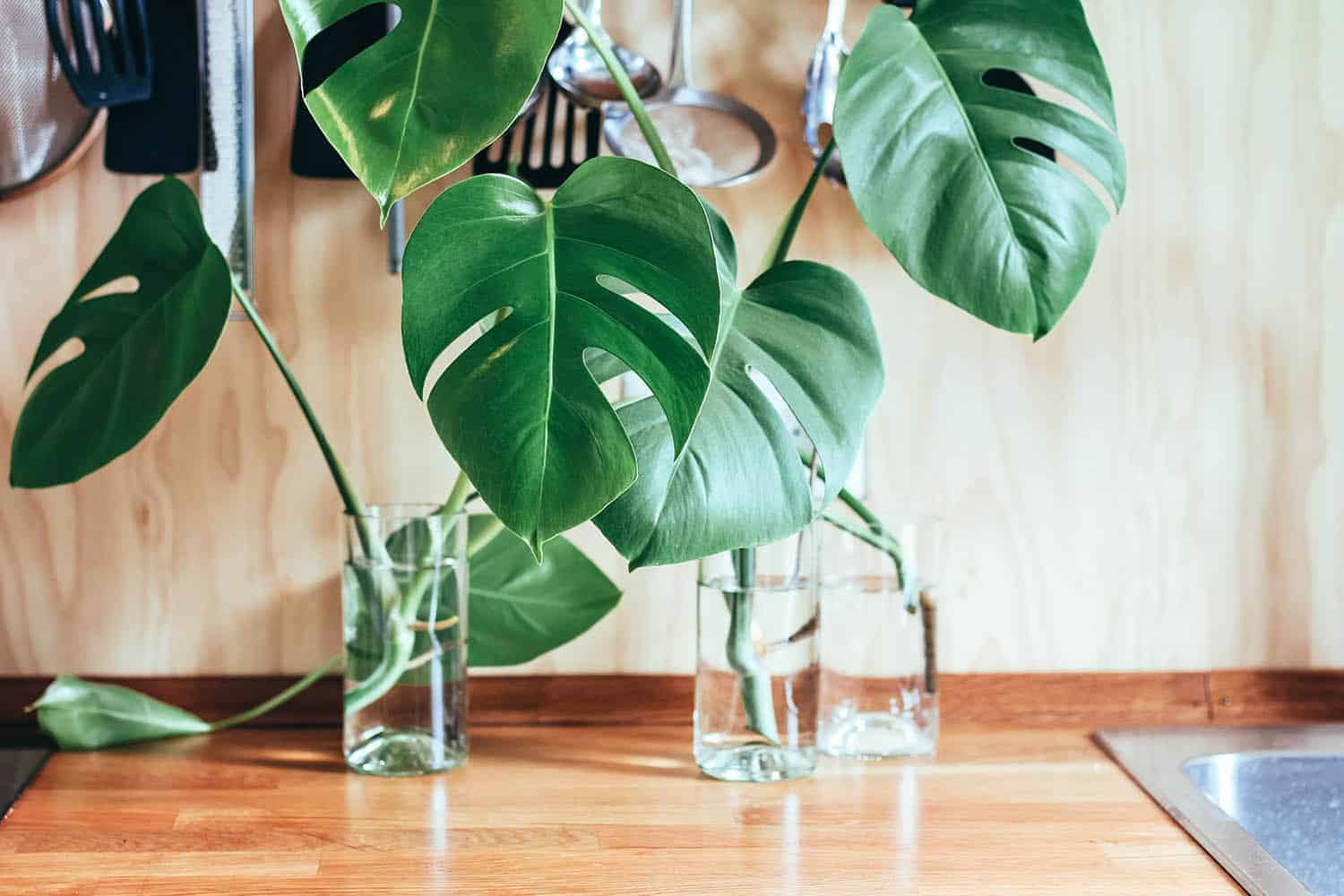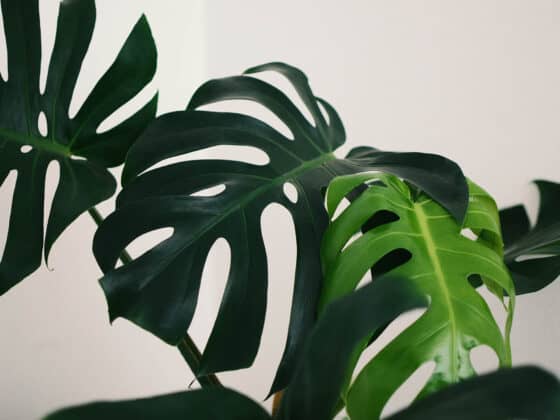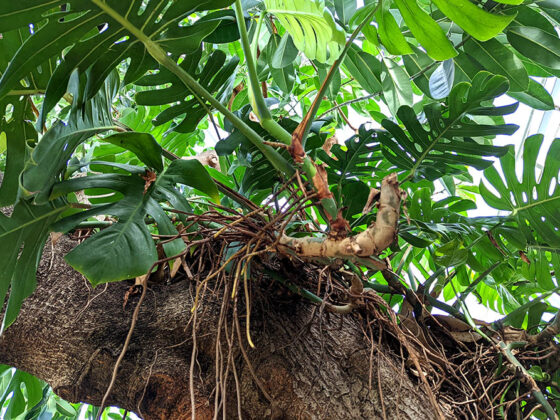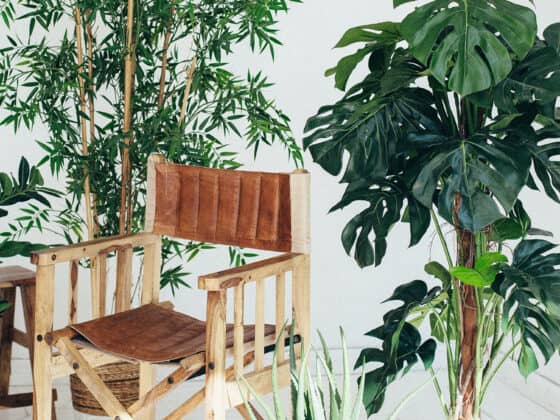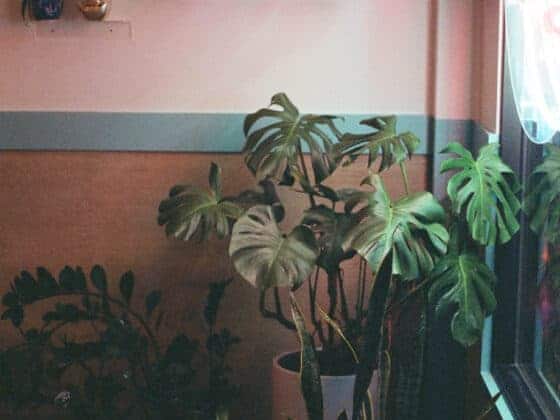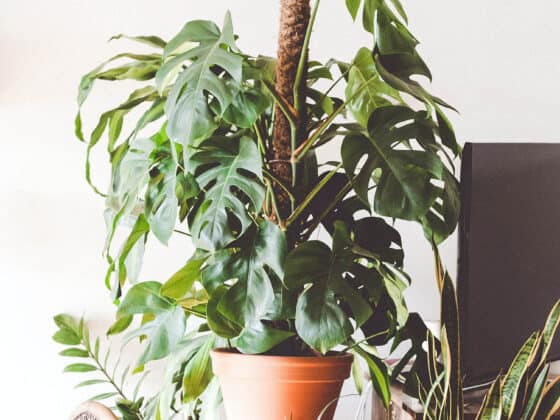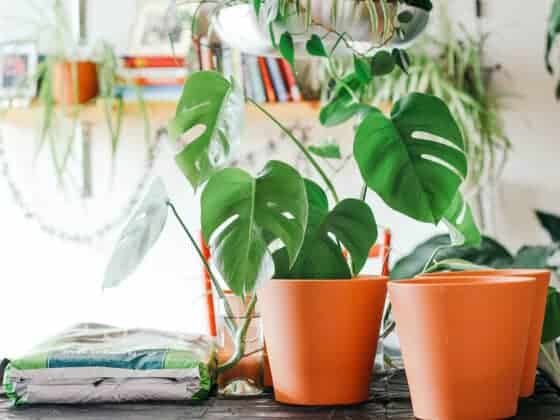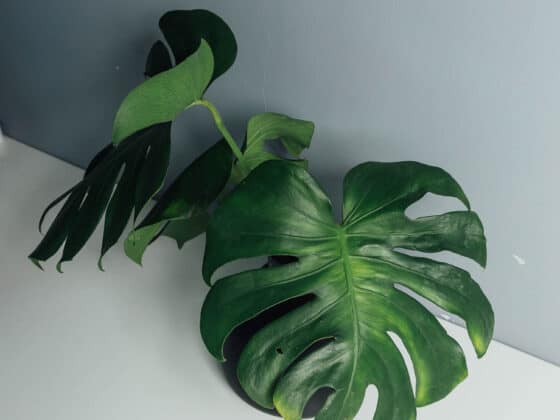Most Monstera owners have tried propagating a stem in water, but have you ever wondered if you could just leave a Monstera deliciosa growing in water long-term? Most information about water propagation assumes that the plant will eventually be moved to soil, but what would happen if you leave your Monstera in water indefinitely?
Can you grow a Monstera deliciosa in water? You can leave a Monstera deliciosa growing in water for quite a long time, but it will never reach its potential in size or health unless it is eventually moved to soil. A Monstera left in water will survive, but it won’t thrive in this environment.
After reviewing the differences between growing plants in water vs. growing them in soil, I believe it is better for the plant to eventually be moved to soil. But while I wouldn’t want to leave the health of my sole Monstera up to a watery existence, it can be a fun experiment to run with propagations and cuttings. If you’d like to try your hand at growing a Monstera in water, it can be done, but there are a few tips and tricks that can help you along your way.
The Short Answer: Can a Monstera Live in Water?
As with so many houseplant questions, the answer is both yes and no. A Monstera can survive for quite a while in water, as long as the cutting contains a node (I’ll cover this in more detail later on in this article). Anecdotally I have heard about people growing Monstera deliciosa cuttings in water for years! However, there are limits to what you can realistically expect if you grow the plant this way.
It makes sense that our house plants do best when we can replicate their natural environment as closely as possible. Monsteras are not aquatic plants, so keeping them in water forces them to adapt to circumstances they wouldn’t find in the wild.
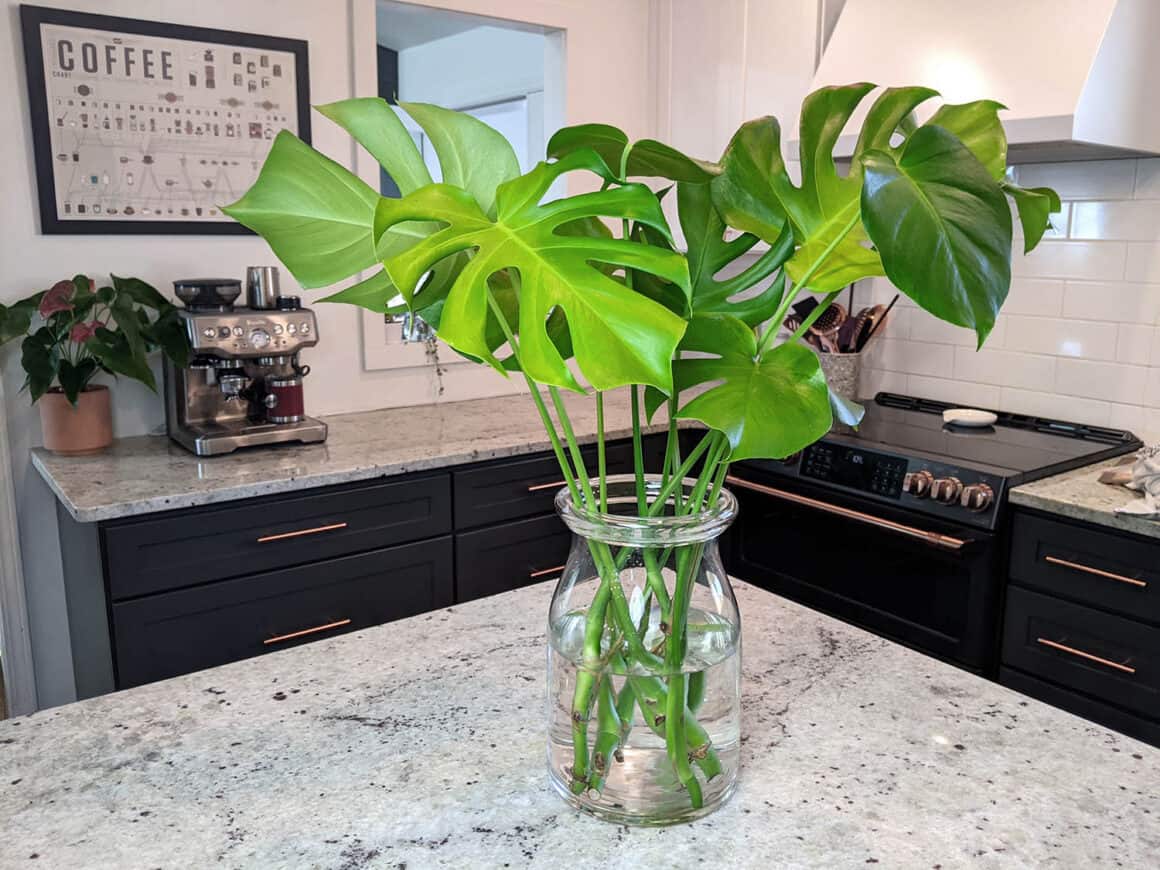
Since Monsteras are very adaptable plants, they can tolerate a variety of conditions. That adaptability is also why we can grow them so successfully indoors. Although they can survive in water, they will not get as big or healthy as a Monstera deliciosa that is provided with a pot of well-draining potting soil mix and something to climb.
If you are like me, one of the main attractions of Monstera deliciosa is its ability to grow to a huge showpiece (their size is the origin of the “monster” part of the Latin name). However, there are some reasons that a person might want to keep this plant in water long-term, which I’ll review in the pros and cons section below.
Will Monsteras Continue to Put Out New Leaves & Growth in Water
In most cases, Monstera cuttings start to grow roots within just a couple of weeks of being placed in a container of water. A new leaf or two will usually follow shortly after if the plant is getting ample light.
However, Monsteras do not get really big when they’re grown in water. Because the environment is unnatural, the plant is not getting the maximum resources to devote to growing. The size will remain smaller than if it were in soil, and leaves will not reach their maximum potential.
Usually, you’ll see a pattern where the plant continues to put out new leaves, but each time that new growth emerges, an older/larger leaf drops off. Even though it generates new growth, the plant basically stays the same size.
How Long Can Monstera Live in Water?
It is difficult to pinpoint exactly how long a Monstera cutting can survive in water. Most plant owners will try to remedy the situation if they see their plant is not doing well, so there are not many instances where a cutting sits in water until it dies. If a Monstera does die in this environment, it is likely that it also didn’t have ideal conditions (frequent water changes and added nutrients, for example).
That said, anecdotally, it seems that many cuttings start to show signs of stress after two or three years in water. As I mentioned, there are some cases where they can last longer than that, but those are atypical.
Pros & Cons of Growing Monsteras in Water
Your Monstera might end up living in water for a while just because you haven’t gotten around to planting it yet, but there are some houseplant owners out there who grow Monstera deliciosa (and a variety of other tropical plants) in water permanently. There are several reasons why, and some of them are very persuasive!
Advantages of Leaving Monteras Growing in Water:
Reduced Chance of Pests. Fungus gnats and molds that live in or on plant soil will be eliminated once the soil is removed. Gnat infestations are one of the more annoying disadvantages of keeping potted plants indoors, so eliminating them is definitely appealing.
You may also find it easier to treat insects that live on plant stems and leaves (like spider mites, aphids, and thrips) because the plant can easily be hosed down without worrying about overwatering.
No Soil in the House. For people whose pets like to dig in their potted plants, this can be a significant benefit. Other people just find the idea of having “dirt” inside their home to be strange and unpleasant and are much more comfortable with water. Not only is it less messy, but you can immediately see if it is cloudy or growing algae. A pot of soil is more mysterious because it hides everything beneath the surface.
Avoid Overwatering. If your main issue with houseplants is providing them a bit too much love, you might like growing plants exclusively in water. It may seem counterintuitive to say that you can avoid overwatering by growing plants in water, but it works because they grow unique water roots designed to absorb the right amount of moisture. Water roots are smaller and more delicate than soil roots.
Containers. I usually make sure all my pots have drainage holes because I know they are vital to keeping my plants happy. Sometimes the best decorative pots don’t have drainage holes, though! If you grow plants in water, you can use those pots without drainage, or really any container. Old jars and vases are popular.
Monitor Root Health Easily. You can see what’s going on with your Monstera’s roots, and remove any damaged or rotted roots right away.
Easier for “Plant-Sitters.” People who travel a lot may feel anxiety about leaving their houseplants in the care of friends or family members who may not be as experienced. It’s much easier for those people to replace or top up a container of water than it is to understand moisture levels and each plant’s individual needs.
Disadvantages of Leaving Monsteras Growing in Water:
Limited Growth Potential. If your goal is to have a towering, impressive Monstera in your house, it isn’t going to happen with a plant growing in water. The plant will limit its own growth to conserve energy in a less-than-ideal situation. Of course, if you are trying to keep your Monstera small, this might be an advantage.
No Soil to Provide Nutrients. Over time, a Monstera growing in water will become deficient in some of the nutrients it would have absorbed from the potting soil (and any added fertilizers in it). It may be necessary to provide special fertilizers to supplement these nutrients.
Worries About pH Levels. I’m no expert on pH levels in water, but my understanding is that the plant may have trouble absorbing nutrients if the level is off. Test kits and additives are available and might be necessary if you want to grow a lot of plants in water.
How to Grow a Monstera in Water
There are a few considerations to making sure that your Monstera is as healthy as possible if you want to grow it in water long-term. First off, you will still need to provide it with plenty of bright, indirect sunlight. They aren’t picky about humidity, and average indoor temperatures suit them fine, but a Monstera needs plenty of light to stay healthy (regardless of if it is in soil or water).
The water should be changed every 2-3 days, ideally, or at least once a week. Changing the water often helps ensure that there is enough oxygen in the water for the plants to “breathe.” In potted plants, there is enough room for oxygen to circulate within the soil, but when a plant is only in water, the oxygen will be depleted over time.
Changing the water often also helps prevent any cloudiness that may occur, usually because some plant material dissolves in the water. Make sure to remove any parts of the plant that are soft or slimy, as those are signs of rot that are not good for your plant’s roots (and can smell bad).
When you replace the water, it is also a good idea to check the roots and rinse them off. When the water is in a clear container, you may find algae growing on the roots or container. While this does not hurt the plant, many people find it unsightly. Using an opaque container or moving it to a slightly less sunny spot can reduce your chances of algae growing.
Note: I have been describing a method for leaving a Monstera deliciosa in water long-term, but I am not covering hydroponic or semi-hydroponic growing methods in this article. Those are both established methods of growing that require different set-up and materials beyond what is covered here.
What Water is Best for Monsteras
The characteristics of your water become more important when you are growing your Monstera in water instead of soil long-term. Commercially available potting mixes usually have some all-purpose fertilizers included, so the plant will no longer have those available when growing in water.
Rainwater is the absolute best for watering all types of plants, and this is no exception. The worst option is what most of us have available – chlorinated water from the faucet. This is because tap water contains chemicals and salts.
With repeated watering, the contaminants from tap water will build up and can damage plants – especially those grown in the limited ecosystem of an indoor container. If you only have access to tap water, leaving it to sit out overnight can allow some of the chlorine to evaporate before you use it.
The reason rainwater is so good for plants is that it already contains nutrients. Rainwater naturally imparts nitrogen to your plants in a form that is easy for them to absorb. It is slightly acidic, which most plants prefer. And rainwater is far less likely than tap water to contain chemicals. (Find out more about the benefits of rainwater here!)
If you do not have access to rainwater, then spring water is also acceptable. If you have access to well water, make sure to test it before using it on your plants as there can be heavy metals or other contaminants in the well. Although Monsteras are not too picky about water, you will get the best results if you use water that is contributing nutrients.
Fertilizing a Monstera That is Growing in Water
As mentioned above, a Monstera growing in water has less access to nutrients than one growing in potting soil. As with most indoor plants, Monsteras do best when supplemented with a fertilizer composed of nitrogen, phosphorus, and potassium.
Regular fertilizer may not be sufficient for plants growing in water since they are also missing nutrients that would have been in the soil. That’s why I recommend using a fertilizer designed for hydroponics like this one. Be sure to follow directions carefully to avoid an overdose, which can damage your plant.
Note that I don’t use fertilizer when I am rooting Monstera cuttings to be planted in soil later because it is unnecessary. Hydroponic fertilizer is only suggested for Monsteras that will be kept in water permanently.
Rooting Monsteras Using Water Propagation
Although growing Monstera deliciosa in water long-term may not be the best choice, water propagation is definitely my recommended method of creating baby Monsteras from your mother plant.
The process of rooting Monsteras in water starts with taking a cutting from your main plant. Then you place the cutting in water until it develops new roots. Then after the roots are a few inches long, plant the cutting in soil.
The important thing to know about rooting Monsteras in water is that you should take a cutting that contains a node. Ideally, it also has 2-3 leaves. You can identify the node by looking for the part of the stem that is thicker, and it may look dry and brown compared to the rest of the stem.
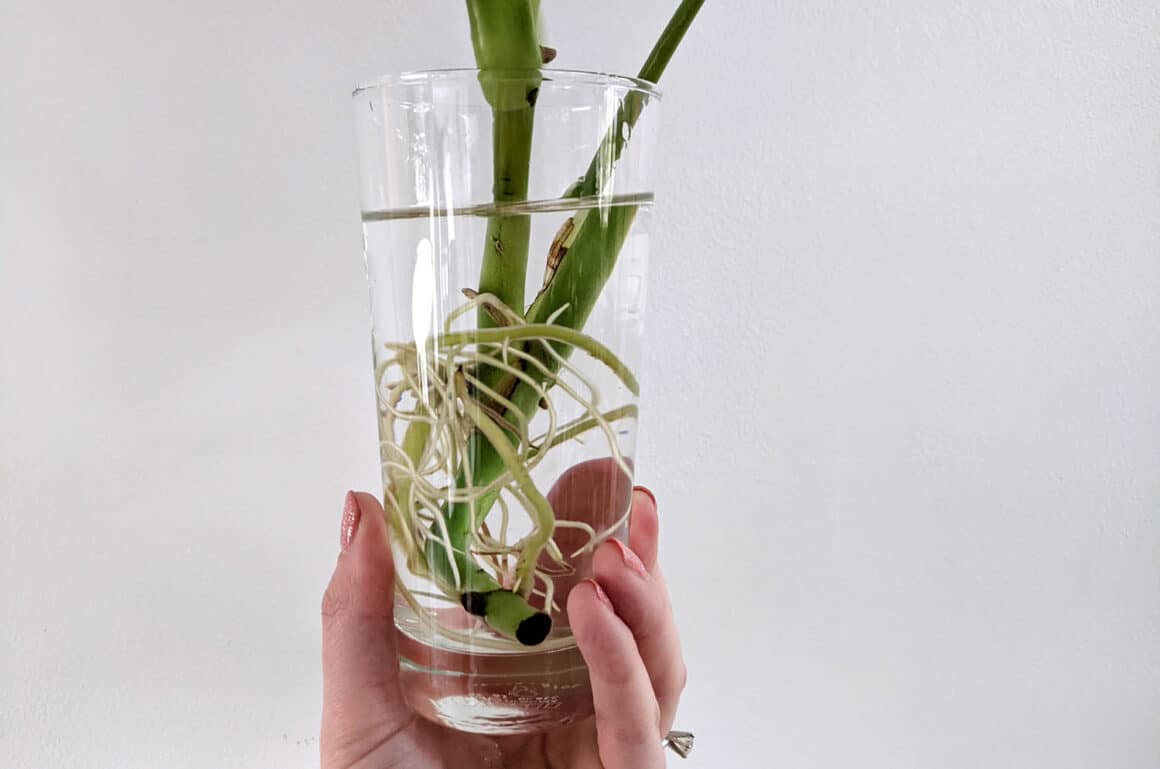
You will usually find nodes just below where stems branch off (creating a V shape), and there may be aerial roots growing from the node already. Nodes are the part of the plant that contain the cells necessary to create roots, so it is vital to cut a piece of the stem that has the whole node included.
I have another article about the importance of nodes when you propagate Monstera deliciosa, which you can read here.
Why Do You Need a Node for A Monstera Cutting?
A Monstera cutting without a node cannot grow into a full-fledged plant, no matter how well it is treated. This is because the node contains the concentration of cells that can generate new growth on the plant. This means any time you have a new stem, leaf, or bud on a plant, it is growing from a node.
A leaf without a node can still be useful, though! If you accidentally break off a leaf or have some left after pruning your Monstera, you can put it in a vase for a striking centerpiece, but just know that a leaf alone will never regrow an entire plant. For more information on why nodes are necessary for propagation, click here.
How Long Will Monstera Leaves Last Water (Without a Node)
A Monstera leaf can look beautiful in water, even if your goal isn’t to propagate it. Florists often use them in arrangements, and the Monstera leaf is likely to outlast the rest of the cut flowers. It is even possible for some fledgling roots to emerge at the base of the stem, which leads people to wonder if they can grow a whole new plant from just a leaf.
Unfortunately, unless the leaf has a node, it is unlikely to live for more than a few weeks. Changing out the water every couple of days will help the leaf stay perky longer, but ultimately (just like all cut flowers), a Monstera leaf without a node will die.
Should I Grow a Monstera in Water Permanently?
Deciding if you want to experiment with growing a Monstera in water is up to you, of course. The nice thing about this is that you don’t need much in the way of special equipment, and the risk is low. Your Monstera cutting may grow perfectly well in water for a while, but if it starts to look unhealthy, it is easy enough to move it to soil to try to get it to recover.
Since Monsteras can tolerate many different growing conditions – plus they’re usually inexpensive and easy to find – they’re the perfect type of plant to play around and experiment with growing in water indefinitely.






